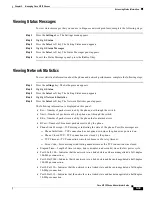
3-46
Cisco SIP IP Phone Administrator Guide
Chapter 3 Managing Cisco SIP IP Phones
Performing an Image Upgrade and Remote Reboot
Step 3
Open the phone configuration file with a text editor and edit the image_version variable to read
P0S30202.
Step 4
Reset each phone.
The phone contacts the TFTP server and requests its configuration files. The phone compares the image
defined in the file to the image that it has stored in Flash memory. If the phone determines that the image
defined in the file differs from the image in Flash memory, it downloads the image defined in the
configuration file (which is stored in the root directory on the TFTP server). Once the new image has
been downloaded, the phone programs that image into Flash memory and then reboots.
Step 5
Copy the new Release 4.0 binary image P0S-3xx-y-zz.bin, where xx is the release major version, y is the
release minor version, and zz is the maintenance number, from Cisco.com to the root directory of the
TFTP server.
Step 6
Using a text editor, open the configuration file and update the image version specified in the
image_version variable. The version name in image_version variable should match the version name
(without the .bin extension) of the latest firmware that you downloaded (for example, P0S3-xx-y-zz).
Step 7
Reset each phone.
Dual Booting from SCCP or MGCP to Release 4.0
Step 1
Copy the P0S30202.bin binary image from Cisco.com to the root directory of the TFTP server.
Step 2
If you are dual booting from a Cisco IP phone running the SCCP or MGCP protocol, open the
OS79XX.TXT file with a text editor and change the file to include P0S30202.
Step 3
Copy the new Release 4.0 binary image P0S3-xx-y-zz.bin, where xx is the release major version, y is the
release minor version, and zz is the maintenance number, from Cisco.com to the root directory of the
TFTP server.
Step 4
Using a text editor, open the configuration file and update the image version specified in the
image_version variable. The version name in image_version variable should match the version name
(without the .bin extension) of the latest firmware that you downloaded (for example, P0S3xx-y-zz).
Step 5
Reset each phone.
The phone contacts the TFTP server and requests its configuration files. The phone compares the image
defined in the file to the image that it has stored in Flash memory. If the phone determines that the image
defined in the file differs from the image in Flash memory, it downloads the image defined in the
configuration file (which is stored in the root directory on the TFTP server). Once the new image has
been downloaded, the phone programs that image into Flash memory and then reboots.
Performing an Image Upgrade and Remote Reboot
With Version 2.0 and newer of the Cisco SIP IP phone, you can perform an image upgrade and remote
reboot using NOTIFY messages and the syncinfo.xml file. The dialplan.xml file can also be pushed
down to the phones using a NOTIFY with a check-sync Event header.
Note
To perform an image upgrade and remote reboot, a SIP proxy server and a TFTP server must exist in the
phone network.






























